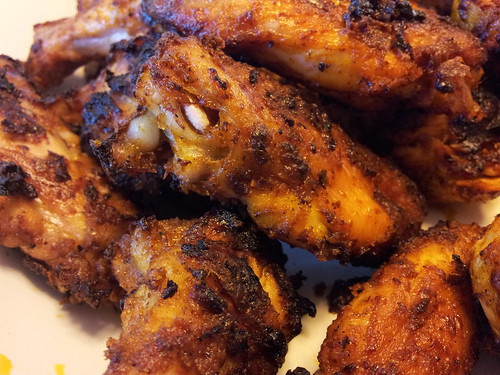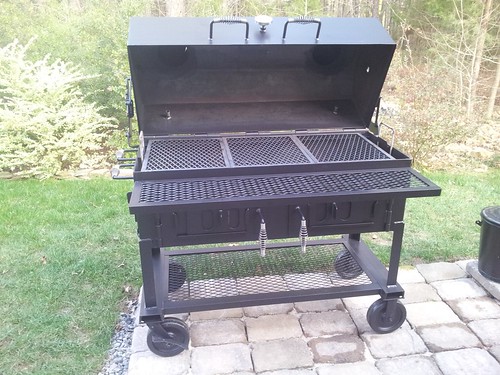April 8, 2012
Tandoori Chicken Wings
So, it has been a while. And what have I been doing with this while? Well, last fall, after many moons of faithful service, my old grill died. I decided to get serious about the new one. Specifically, I had one made by Klose. I dub it "The Beast":
Anyway, it took me a while to get the back ready to receive The Beast, but I have now been happily grilling for around a month (well, less than cooperative weather permitting). I am still at the stage of getting the feel for the beast, but yesterday I landed a dish which is the subject of this post.
The dish for today is Tandoori chicken wings. Yesterday's try was the second iteration, and my description of the dish will include lessons learned from the first effort.
To begin with, you have to make Tandoori sauce. To do this, rough chop a medium onion, two inches of ginger, and 4 garlic cloves. Toss in a food processor with:
-the zest of 1 lemon;
-1 cup of plain (no need for Greek) yogurt;
-1/2 cup of vegetable oil (and don't be afraid to splash a little);
-1 Tablespoon of ground coriander;
-1 teaspoon of ground cumin;
-1 teaspoon of turmeric;
-1 teaspoon of gram masala;
-1/2 teaspoon nutmeg;
-1/2 teaspoon cinnamon;
-1/4 teaspoon of fresh, and finely, cracked black pepper.
Blend all of these ingredients together in a food processor to make the smoothest Tandoori sauce possible (maybe 3-5 minutes in low pulse). Two notes about this:
1. The resulting Tandoori grill will yield pretty yellow meat. The usual solution for this at Indian restaurants in the US is red food coloring. I tend to increase the dosage of all the spices by 10-20% (e.g. heaping teaspoons/Tablespoon) and add in around a Tablespoon of ground annatto seed to generate some red tinge.
2. This is twice the oil called for in the original recipe that I started working off of. On the first try I felt that the char on the Tandoori was excessive, in large part because the sauce was too thick. I decided to loosen it up a bit and add a phase (described below) where excess sauce would be drained before grilling.
Anyway, take this sauce and pour into a baking pan or some other shallow-ish pan that can be used for marinating. Add to that 3-3.5 pounds of chicken wings (30-35 wings) and stir around to coat with the sauce. (The wings should be 75-85 percent submerged in the sauce, with a sauce layer over the top.)
Cover the pan with Saran wrap and place in the fridge to marinate for 6-12, and up to 24, hours. The longer it goes the more deeply the color will take to the chicken. If need be, stir the wings around every so often to insure more even marinating.
20 minutes before you are ready to put meat to heat, remove the wings from the pan to a bakers cooling sheet (pictured in the next photo) to drain excess Tandoori sauce. After 10 minutes of so flip the wings to insure even drainage.This drainage is key to preventing char (the excess sauce providing in some sense the fuel for char). It won't seem like much drains off, but what does drain is just enough to make the difference. Discard remaining Tandoori sauce.
Meanwhile, I was firing up The Beast. The first time I tried this recipe I did indirect high (>500° F (260° C)) heat. This was too much and, along with extra coating of thick sauce on the wings, generated a lot of char.
The second, successful time, I did indirect medium heat. I fired two charcoal firestarter chimneys and poured one on each on either side of the grill. I then closed the lid to build a bit of heat, toward around 350° F (176.7° C) to 400° F (204.4° C), with a sweet spot of 375° F (190.5° C).
Once draining is complete, put meat to heat. The first step, as always, is to lubricate the grill surface. Use an oil that does well under the high heat, such as grapeseed or peanut oil. Use tongs and some kind of cloth or paper (coffee filters being a favorite of mine) to spread some oil on the clean grill grates.
As you can see from the photo below, I put the wings between two medium fires to insure even heating.
The wings on the upper deck were experimental (great success)! This means that, in principal, I could grill 7 pounds of wings at once on The Beast! That said, if I were doing two different types, the type not presauced would be on the top deck.
As indicated, the target temperature range was 350° F (176.7° C) to 400° F (204.4° C), with a sweet spot of 375° F (190.5° C). I achieved this, once the two chimneys of coals were in, mostly by vent manipulation. To maintain these temperatures, I periodically placed individual pieces of hardwood charcoal on the two fires using tongs.
I would flip the wings fairly frequently (first, around 10-12 minutes in and then at 8-10 minute intervals). To do so, first gently loosen the wing from the grill with the spatula. This is particularly important on the first flip.
I can't remember the total cooking time, but let's call it 35-40 minutes. One more shot of food porn:
The wings actually had a slight red tint not captured under this yellow light.
We served the wings with raita. Simple recipe: mix Greek yogurt with warm water until the yogurt is quite viscous. The toss in a peeled, cored and finedly chopped cucumber. You can add in a cored, seeded tomato finely chopped and/or the same for red bell pepper, as well. Toss in some cilantro and mint to taste, and you can also squeeze in some juice from the lemon used earlier.
So, to be clear, for successful Tandoori wings (or probably successful Tandoori anything else):
1. Get rid of excess sauce;
2. Control the heat.
Posted by dag at April 8, 2012 7:01 AM
Comments
Great info. Lucky me I found your blog by accident (stumbleupon).
I have saved as a favorite for later!
Posted by: online book of ra at June 19, 2012 5:43 AM





